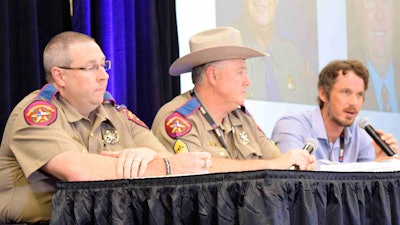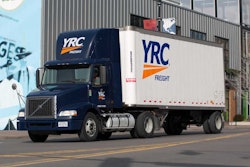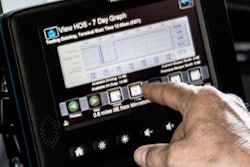 From left: Lt. Monty Kea, Sgt. Dana Moore and Overdrive Senior Editor Todd Dills.
From left: Lt. Monty Kea, Sgt. Dana Moore and Overdrive Senior Editor Todd Dills.Roadside inspectors, at least in Texas, will give drivers the “benefit of the doubt” when it comes to verifying electronic logging device mandate exemptions in the months following the Dec. 18 ELD adoption deadline.
That was the message from Sgt. Dana Moore of the Texas Department of Public Safety in a panel held Thursday at the Great American Trucking Show, which also included DPS Lt. Monty Kea and Overdrive Senior Editor Todd Dills. Panelists intended to clarify questions related to ELD enforcement at roadside inspections in the special GATS session.
“The question is: Do we go forward and cite something or do we back off and check on it later?” Moore asked. The Federal Motor Carrier Safety Administration recently changed the exemption to using ELDs to pre-2000 model year engines. The earlier interpretation stressed the model year of the truck to determine the exemption.
“We’re just going to accept [drivers’ word] at roadside” of the year-model of the engine, he said, “unless we have some evidence to say otherwise.” Officers will file requests with FMCSA enforcers to follow-up if the engine year can’t be verified in a roadside inspection. That approach is in line with FMCSA’s direction on the pre-2000 exemption: If an officer can’t verify the engine’s year, they’re told to file a request with FMCSA to verify.
FMCSA recently altered the pre-2000 exemption from the truck’s year-model, as indicated by the truck’s VIN number, to the engine year-model, as indicated on the engine plate. Carriers are required to keep documentation of the year-model of their engine at their principal place of business, but not in the truck itself. If an operator tells a roadside inspector he’s exempt from the mandate, officers will try to determine the engine year-model on the engine itself.
Moore noted the difficulty likely associated with that, however, as plates can be “at the very bottom of the engine, under an inch of dirt and grease.”
Officers in Texas will allow operators to continue operating, Moore noted, rather than slapping them with the 10-hour out-of-service order associated with a lack of ELD compliance. As a follow-in, officers in such cases will submit a request to FMCSA to investigate further. FMCSA could send auditors to verify the exemption is warranted.
Similarly, if a driver claims an exemption at roadside related to not operating more than eight days in a thirty-day period beyond the short-haul air mail radius, inspectors will try to verify the claim. If it can’t be determined at roadside, inspectors are likely to give the operator a pass, then file a request with FMCSA to follow up, says Moore.
“There’s so much at a roadside inspection that we won’t be able to determine,” Moore says. “If we do suspect a driver is not using an ELD [and should be], we’re going to submit that,” which could prompt “auditors to come out and start checking records,” he adds.
Roadside with ELD malfunctions
Should an operator’s’ ELD fail or malfunction, they must notify their carrier within 24 hours and reconstruct their previous seven days’ logs on a paper log, blank copies of which are required to be kept on hand.
“They must continue to manually prepare records of duty status on paper logs until the malfunction has been corrected,” says La Tonya Mimms, a transportation specialist in FMCSA’s enforcement division. She spoke in a separate ELD panel at GATS Thursday.
Carriers will then have eight days to repair or replace their unit.
Should an ELD continue to properly record records of duty status but fail to transfer the data at roadside to an officer via the four methods specified in the rule, they must be able to either print their logs or show an inspector their current-logs display screen. “It doesn’t have to do both, just one or the other,” says Mimms.











